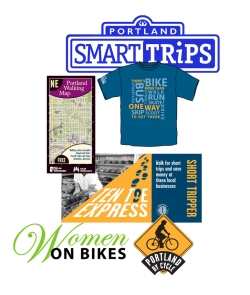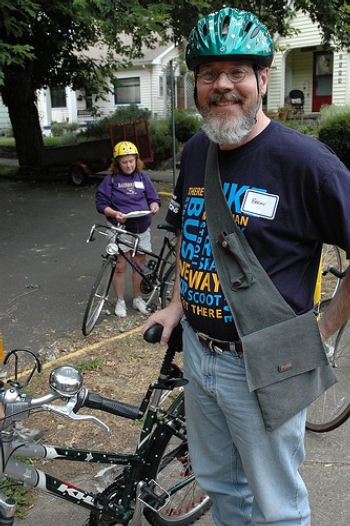Portland SmartTrips
Portland, Oregon
Source: Pedestrian and Bicycle Information Center (PBIC)
Problem
Portland residents choose single-occupancy car trips as their primary mode of transportation. Besides poor community health and safety, this choice creates road congestion that compromises the region's economic vitality. The Portland area is the third most trade- and freight-dependent region in the U.S.; its economy will suffer if nothing is done to get cars off the roads. Most personal everyday trips are three miles or less and easily could be made by safer and healthier modes of transportation — walking, bicycling and transit. The city has an economic incentive to encourage these alternate modes.

An array of brochures, maps, incentives, and events contributes to the effectiveness of the SmartTrips marketing program. images: City of Portland
Background
In 2002 the Portland Office of Transportation brought the individualized marketing program TravelSmart to the United States from Australia and Europe to reduce drive-alone trips and increase walking, bicycling, transit, and carpool trips. The pilot project was conducted in 2003 with 600 households; a large-scale project with 6,100 households followed in 2004. After working with the TravelSmart architects SocialData America for these two projects, Portland modified the program to reduce costs, add hands-on experiential activities, and extend the contact period with residents to a longer, eight-month dialogue.
The result was SmartTrips.
Solution
SmartTrips is a comprehensive approach to reduce drive-alone trips and increase biking, walking, and public transit in targeted geographic areas of the city. It incorporates an innovative and highly effective individualized marketing methodology, which hand-delivers packets of information to residents who wish to learn more about all their transportation options including transit, walking, bicycling, carpooling, car sharing, and combining trips. Key components feature biking and walking maps and organized activities that get people out in their neighborhoods or places of employment to shop, work, and discover how many trips they can easily, conveniently, and safely make without using a car. Success is tracked by evaluating qualitative and quantitative results from surveys and other performance measures.
The project has five primary goals:
- reducing drive alone trips
- reducing vehicle miles driven by area residents and employees
- increasing awareness and raising acceptability of all travel modes
- increasing walking, biking, transit, carpooling and car sharing trips
- increasing neighborhood mobility and livability.
The Transportation Options Division of the Portland Office of Transportation chooses an area of town with approximately 20,000 households each year to implement this program. Area selection is based on analyzing land use patterns, transit service availability, bike and walking infrastructure, and current transit or streetscape infrastructure investments such as new light rail or bicycle and pedestrian trails.
SmartTrips Individualized Marketing
In late March, each household in a SmartTrips area receives a newsletter with a calendar of nearby walks, clinics, and bicycle rides. The newsletter highlights SmartTrips programs, including the Ten Toe Express Walking Campaign, Portland By Cycle Campaign, Senior Strolls, and Women on Bikes. The newsletter articles also describe other transportation projects and programs such as Safe Routes to School, an area streetscape project, and how to use the transit agency's services.
The first newsletter includes a notice about the SmartTrips Order Form that residents use to get information and incentives about walking, bicycling, transit, carpooling, and more. The Options Division sends order forms in waves to approximately 2,500 households each week. The three members of the Options delivery staff process and deliver the materials and incentives within a two-week period — usually within one week of receiving an order. Three weeks after the order form is sent, Options mails a reminder postcard with the Web order form address and a phone number for requesting an order form by mail.
Speed, efficiency, and professional materials are central to making the program a success. A packet delivered six weeks after it's ordered is too late. A bicycle delivery person hand-delivers each packet or leaves it in a conspicuous spot. Residents receive their requested materials in a handy vinyl tote bag with an attached, personalized paper luggage tag. A thank-you letter, SmartTrips Calendar of events, and area walking map are included in every delivery bag.
Residents can order a variety of maps, brochures, tips, and event schedules for every mode of transportation: walking, bicycling, transit, carpool, car sharing, and driving.
- Walking — The "Ten Toe Walking" kit includes a free pedometer donated by Kaiser Permanente plus a schedule of neighborhood walking tours, a Walk to Wellness brochure highlighting area programs focused on walking and health, walking logs to keep count of daily steps, an Oregon Crosswalk Laws brochure, and an area walking map. Each of these items can be ordered à la carte as well. The kit also includes a shopping list pad and a 72-coupon booklet for area businesses. A Senior Stroll schedule and description of walks is also available.
- Bicycling — The Portland By Cycle kit includes citywide and neighborhood bicycle maps, a Portland By Cycle Guide with tips and rules of the road, Portland By Cycle Rides and Workshop schedules, a Women on Bikes Rides and Clinics brochure, a personalized bicycle trip planning request postcard, a TriMet Bikes on Transit Guide, a leg strap, and a 72-coupon booklet for area businesses. Additional items can be ordered à la carte: the Oregon Bicycling Manual with the rules of the road, a City of Portland downtown bicycling map and other neighborhood bike maps, a Women on Bikes Resource guide, and a Bicycle Helmet brochure.
- Transit — All bus and light rail schedules, the Honored Citizen's Guide for seniors and the disabled, and a personalized transit tracker card can be ordered. The transit tracker card gives the four bus stop ID numbers, in and outbound, for the closest stops to the resident's home. With this information the resident can call the bus/MAX stop for real-time bus arrival information — not just the scheduled time.
- Driving — Car sharing, carpooling, and older driver information can be ordered, including safety guidelines for older drivers.
With each order one incentive may be chosen: a SmartTrips umbrella, Bandana Bicycle Map, or Transportation Options T-shirt.
On May 1 all area residents receive a second newsletter reminding them to order materials, and listing the Web address, phone number, and more events and activities. Everyone who orders materials or attends one or more of the walks and rides gets the final three newsletters every two months: July 1, September 1, and mid-November.
SmartTrips Events and Activities
Ten Toe Express Walks — To help people get started and meet others to walk with, the Options Division organizes four to six guided walks each month from May to September in the SmartTrips area. Some are short, some are long; all highlight great places to walk within area neighborhoods.
Senior Strolls — As with Ten Toe Express Walks, Senior Strolls help seniors connect with each other while they become comfortable with walking as a transportation option. The slower paced strolls, which start and end on TriMet routes, teach seniors about different neighborhoods and offer the benefit of meeting other seniors to walk with; they are offered weekly May through October.
Portland By Cycle Rides and Classes — Portland By Cycle includes a series of evening rides and classes May through September. The rides are designed for new and infrequent cyclists. Participants tour various parts of the SmartTrips area and learn the best ways to get around by bike. A safety briefing opens the ride program; safety tips are offered along the ride by trained volunteer and staff ride leaders.
Options works with individuals and organizations to offer eight free classes that provide more specific information on bicycling. Topics include shopping by bicycle, introduction to bike commuting, bicycle touring, riding in the rain, and basic bike maintenance.
Women on Bikes — Women on Bikes is a series of clinics, conversations, and rides. Topics of the clinics and conversations include bike selection, gear for bike and cyclist, bike handling skills, basic bike maintenance, the city's bikeway network, cyclists' rights and responsibilities, how to ride with children, how to shop by bike, and advocacy. Rides are scheduled to practice skills, try different routes, meet other women to ride with, and demonstrate the ease of commuting by bike.
Events/OptionsMobile — The OptionsMobile, a Honda Insight hybrid vehicle, is scheduled in as many outreach events in the SmartTrips area as staff can accommodate with either volunteers (Ambassadors) and/or staff. At events, the Options staff distributes all SmartTrips materials, schedules and safety information, and offers personal assistance to those with questions and concerns.

Portland By Cycle rides offer information, experience, and support for those new to cycling. photo: City of Portland
Results
SmartTrips and TravelSmart projects have yielded a reduction of 9 to 13 percent in drive-alone car trips by all area residents with a corresponding increase in walking, bicycling, and transit mode shares in the SmartTrips areas. These results were collected through random telephone surveys of 300 to 600 households in each SmartTrips area with a corresponding control group. Trip diaries from survey participants capture trip activity for the previous day with calls made over a two-week period to get weekday and weekend data. For more detailed information about the results methodology, check the SmartTrips final reports on the Web site listed below.
All SmartTrips area residents receive SmartTrips messages at least seven times through mailers, media coverage, and outreach events. Approximately 30 percent of all area residents either ordered materials or participated in a SmartTrips event or activity. (Each walk generally draws from 30 to 50 participants; new people attend each time. Each bike ride attracts about 18 cyclists, but there have been as many 75 on some rides.) Twenty percent of all households order materials.
Area residents submit annually an average of 1,000 comments praising the program, some describing how it prompted them to change the way they get around and how much they love living in Portland because of programs like SmartTrips. These kudos help make it a popular program with politicians, agency staff, and neighborhood leaders.
Costs
The program costs $10 per person in the SmartTrips area. A typical 20,000-household program costs $570,000. This cost includes 4.35 FT staff and most materials and services. Staff overhead is included in this number, but computer and general overhead and printing bicycle maps and transit schedules are not.
Contact
Linda Ginenthal
1120 SW 5th Avenue, 8th floor
Portland OR 97204
(503) 823-5266
linda.ginenthal@pdxtrans.org
www.GettingAroundPortland.org
Image sources
City of Portland




